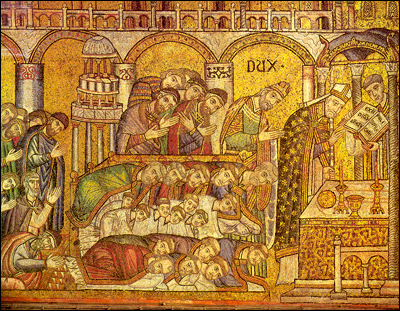Acquiring the Mind of the Church
Père Congar in 1963 quoted by Geoffrey Hull in The Banished Heart, 2010:
Nothing is more educative for man in his totality than the liturgy. The Bible is certainly a marvelous teacher of prayer, of the sense of God and of the adult convictions of conscience. Used alone, the Bible might produce a Christian of the Puritan tradition, an individualist and even a visionary. The liturgy, however, is the “authentic method instituted by the Church to unite souls to Jesus” (Dom Maurice Festugière). The sort of Christian produced by an enlightened and docile participation in the liturgy is a man of peace and unified in every fibre of his human nature by the secret and powerful penetration of faith and love in his life, throughout a period of prayer and worship, during which he learned, at his mothers knee and without effort, the Church’s language: her language of faith, love, hope, and fidelity. There is no better way of acquiring “the mind of the Church” in the widest and most interior interpretation of this expression.
I have always believed this. It corresponds to my own experience of the traditional liturgy in the context of monastic life, and I agree wholeheartedly with the marvelous affirmation made by Dom Festugière. It raises a question nonetheless. Can the same thing still be said in so unqualified a way and to the same degree of the current reformed liturgy with its multiple options and opportunities for “personalisation” by the celebrant?


Dear Father Mark,
First of all I want to thank you for this post; it was very meaningful to me. My thoughts were immediately turned towards an Italian Carthusian publication I have which states: ‘Il sacrificio eucaristico è il centro e l‘apice della nostra vita – The Eucharistic Sacrifice is the centre and apex of our life’. It also says (and I’m paraphrasing) that being ever awake to the presence of God makes our whole life a liturgy. Thus, to me, the quote from your post hits the nail on the head.
To me personally, there is nothing more aesthetically pleasing and interiorly moving as the traditional High Mass. I’m convinced that the thought of a proper implementation of the Second Vatican Council scared the devil out of the devil. He sure seemed to make great efforts to make it go awry. How else could we explain the destruction of communion rails, the tabernacle being removed from the centre of the altar, the versus populum posture of the priest at the altar, the adlibbing of the Sacramentary, etc. – none of which came from the Second Vatican Council. Cardinal Arinze on more than one occasion has called the reformed liturgy the ‘do it yourself Mass’. Obviously the Council Fathers did not foresee any of these destructions occurring. I think the Holy Father is on the correct path, but he always seems to meet with much resistance. I’m disappointed when I hear the Church’s ordained members defend and promote keeping things the way they are for the sake of the ‘Spirit of Vatican II’. That to me seems like a terribly misleading statement, since what has been occurring for forty plus years has nothing to do with the blueprint of the Second Vatican Council Fathers.
Thank you Fr. Mark for bringing
up that simple point of how the
Liturgy is made, “personalized”,
by those who wish to, ” do their
own thing”, in the style of hippies.
I think there is room for choice
in terms of individual preference
as a general way of doing things
as a Christian. Not everyone has
a vocation like everyone else and
this produces different points of
focus for everyone in the Liturgy.
I may not know what I am talking
about considering I am a humble
baptized candidate for Confirmation.
P.